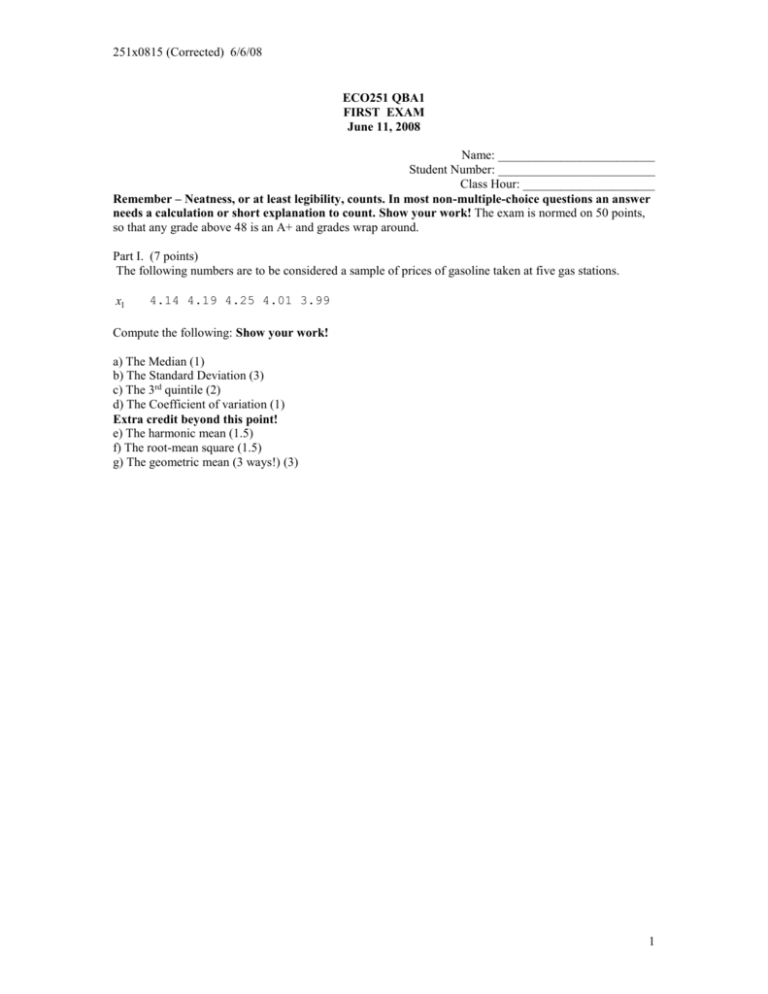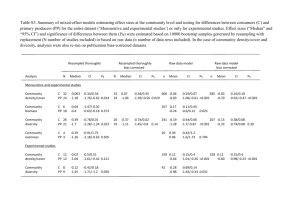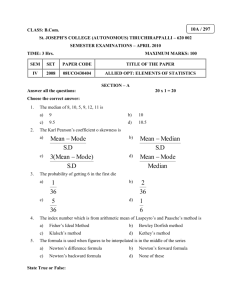251x0815
advertisement

251x0815 (Corrected) 6/6/08 ECO251 QBA1 FIRST EXAM June 11, 2008 Name: _________________________ Student Number: _________________________ Class Hour: _____________________ Remember – Neatness, or at least legibility, counts. In most non-multiple-choice questions an answer needs a calculation or short explanation to count. Show your work! The exam is normed on 50 points, so that any grade above 48 is an A+ and grades wrap around. Part I. (7 points) The following numbers are to be considered a sample of prices of gasoline taken at five gas stations. x1 4.14 4.19 4.25 4.01 3.99 Compute the following: Show your work! a) The Median (1) b) The Standard Deviation (3) c) The 3rd quintile (2) d) The Coefficient of variation (1) Extra credit beyond this point! e) The harmonic mean (1.5) f) The root-mean square (1.5) g) The geometric mean (3 ways!) (3) 1 251x0815 (Corrected) 6/6/08 Part II. (18 points) According to Anderson, Sweeny and Williams a bank found the following as a sample of 30 waiting times (in seconds) for service. Row 1 2 3 4 5 Time 60-119.99 120-179.99 180-239.99 240-299.99 300-359.99 Frequency 6 10 8 4 2 a. Calculate the Cumulative Frequency (1) b. Calculate the Mean (1) c. Calculate the Median (2) d. Calculate the Mode (1) e. Calculate the Variance (3) f. Calculate the Standard Deviation (2) g. Calculate the Interquartile Range (3) h. Calculate a Statistic showing Skewness and interpret it (3) i. Make a frequency polygon of the data (Neatness Counts!)(2) 2 251x0815 (Corrected) 6/6/08 (Blank page for calculations) 3 251x0815 (Corrected) 6/6/08 Part III. Multiple choice (12 points). Note: If you say ‘None of the above,’ you should supply a correct answer to get full credit. 1. If a distribution is skewed to the right, the following must be true. (Hint: making a diagram first is a good way to prevent errors.) a. Mean < median < mode b. Median < mean < mode c. Mode < median < mean d. Mode < mean < median e. Mean = median = mode f. None of the above. 2. If I have a population described as grouped data and I am using definitional formulas. f x 0 a. b. f x 0 c. f x 1 d. None of the above. 3. Which of the following does not describe a population? a. x b. c. The coefficient of variation d. e. Pearson’s coefficient of skewness. f. g. All of the above describe a population. 4. Mark the following items N (nominal), O (ordinal), I (interval) or R (ratio) data. If the data is interval or ratio data, would it be considered C (continuous) or D (discrete)? (4) a) Likert Scale - The format of a typical five-level Likert item is: 1) Strongly disagree; 2) Disagree; 3) Neither agree nor disagree; 4) Agree; 5) Strongly agree ________ b) Next year’s tuition (in dollars and cents) ________ c) Place of residence __________ d) Number of credit cards that you hold _________ 5. If you make a graph to represent a data set, the following should be plotted at class midpoints. a. An ogive b. A frequency polygon c. A Pareto diagram d. All of the above e. None of the above 4 251x0815 (Corrected) 6/6/08 Part IV. (13+ points) Table 1 Given below is a stem-and-leaf display for the amount of gas purchased at a service station. Minitab gives the following information. (SE Mean is the standard deviation divided by the square root of n . MTB > describe c1 Descriptive Statistics: x Variable x n 25 Mean SE Mean 11.372 0.232 StDev 1.158 Minimum 9.100 Q1 Median Q3 Maximum …………… ………… ………… 13.200 9|147 10|02238 11|125566777 12|223489 13|02 1. In Table 1, what is the median purchase? (2) 2. Create a 5-number summary from Table 1. (4) 3. In Table 1, assume that you were asked to present the data in 4 classes. Using the method you learned in class, show how you would decide what class interval to use and list the classes below with their frequencies. (4) [10] Class A B C D ___ ___ ___ ___ to to to to under under under under Frequency ___ ___ ___ ___ ___ ___ ___ ___ 4. In Table 1, according to the Tchebyschev inequality, what is the minimum number of observations that should be between 9.056 and 13.688? What would the empirical rule say? Should the empirical rule apply here? Why? (4) 5. Which of the following are not sensitive to extreme values? (Circle all correct answers.) (3) a. The mode b. The mean c. The variance d. The coefficient of variation e. k 3 , the third k-statistic. 5






